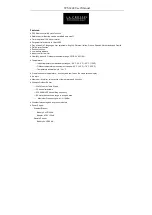
A-5
K. Hot Start (V
###
-S only): In stick welding mode, this
controls the amount of current used during the start
of the arc to help ignite the arc quickly and reliably.
In TIG welding mode, this is not used.
L. Arc Force (V
###
-S only): In stick welding mode, this
controls the amount of current used during any
intermittent short circuiting of the electrode during
welding. In TIG welding mode, this is not used.
M. Trigger Mode Switch (V
###
-T / -TP only): This switch
changes between 2-step and 4-step trigger
sequences. For an explanation of these trigger
sequences refer to the trigger sequences explained
below.
N. Pulsing Mode Switch (V
###
-TP only): In the TIG
welding modes, this switch turns the pulsing
function ON and controls the pulsing frequency
range (20Hz or 300Hz). In Stick welding mode, this
is not used.
The Pulsing LED next to the Pulsing Mode Switch
shows the pulsing frequency when pulsing is turned
ON. With this indication, the operator can adjust the
frequency to the desired value before welding.
(Note: At higher frequencies the LED flashes very
fast and seems to be continuously ON however it is
pulsing.)
O. Pulsing Frequency Control (V
###
-TP only): When
the pulsing function is ON, this control knob will
adjust the pulsing frequency. The pulsing frequency
adjustment range is 0.2-20Hz or 3-300Hz
depending on the Pulsing Mode Switch position.
P. Pulsing On-time Control (V
###
-TP only): When the
pulsing function is ON, this control knob will adjust
the pulsing on-time. The on-time can be adjusted
from 10% to 90% of the pulsing period.
Q. Pulsing Background Current Control (V
###
-TP only):
When the pulsing function is ON, this control knob
will adjust the pulsing background current. This is
the current during the low portion of the pulse
waveform; it can be adjusted from 10% to 90% of
the welding current.
R. Downslope Control (V
###
-T / -TP only): In the TIG
welding modes, this control knob will adjust the
downslope time from 0.5 to 20 seconds. (The
upslope time is always 0.5 seconds.) Refer to the
trigger sequence section below to understand how
downslope is activated. In Stick welding mode, this
is not used.
S. Start/Crater Current Control (V
###
-TP only): This
control knob will adjust the Start/Crater current from
10% to 90% of the welding current. For an
explanation of the start/crater operation, refer to the
trigger sequences explained below.
T. Postflow Control (V
###
-T / -TP only): In the TIG
welding modes, this control knob will adjust the
shielding gas postflow time from 0.5 to 30 seconds.
(The preflow time is always 0.5 seconds.) In Stick
welding mode, this is not used.
U. VRD LED's (enabled on Australian Machines only):
This machine is provided by VRD (Voltage
Reduction Device) function: this reduces the
voltage at the output leads.
The VRD function is enabled by factory default
only on machines that meet the AS 1674.2
Australian Standards.
(C-Tick logo " " on/near
the Rating Plate applied on the machine).
The VRD LED is ON
when the Output Voltage is
below 32V with the Machine at idle (no welding
time).
For others machines this function is disabled
(the LED is always OFF).
TIG Trigger Sequences
TIG welding can be done in either the 2-step or 4-step
mode. The specific sequences of operation for these
two trigger modes are explained below.
2-Step TIG Sequence
With the 2-step trigger mode and a TIG welding mode
selected, the following welding sequence will occur.
1. Press and hold the TIG torch trigger to start the
sequence. The machine will open the gas valve to
start the flow of the shielding gas. After the preflow
time, to purge air from the torch hose, the output of
the machine is turned ON. At this time the arc is
started according to the selected welding mode.
After the arc is started the output current will be
increased at a controlled rate, or upslope time, until
the Welding current is reached.
2. Release the TIG torch trigger to stop welding. The
machine will now decrease the output current at a
controlled rate, or downslope time, until the Crater
current is reached and the output of the machine is
turned OFF.
After the arc is turned OFF, the gas valve will
remain open to continue the flow of the shielding
gas to the hot electrode and work piece.













































